

Hisense offers calibration options for SDR and HDR through the Autocal workflow. While most settings are automatically configured, HDR calibration necessitates manual adjustment of specific settings, which will be noted in the workflow.
Requirements
Calman Required Version
- Calman Studio, Video Pro, or Ultimate
- Calman 2024 v5.15.2 or newer
Calman Required Workflows
- Hisense AutoCal Workflow
Required Hardware
- HDR Compatible Pattern Generator
- HDR Compatible Meter
- For information see Calman Compatible Meters
- Calman Compatible Hisense TV
- Hisense 2023- Models
TV setup:
- Complete TV network setup and ensure TV is connected to the same local area network as the computer running Calman software
- Connect the Calman-supported pattern generator to the TV’s HDMI 1 Port with a certified (at least HDMI 2.0 grade) cable.
- Verify Calman Services is enabled by selecting Settings → Picture → Calibration Settings → Calman Services
Getting Started

- From the Calman Menu in the top-left, choose Open Workflow Template > Display Specific and then AutoCal – Hisense
- Select calibration mode (colorspace) and display type
- Click Next to proceed to calibration
SDR Calibration
Show/Hide SDR Calibration Steps
Step 1
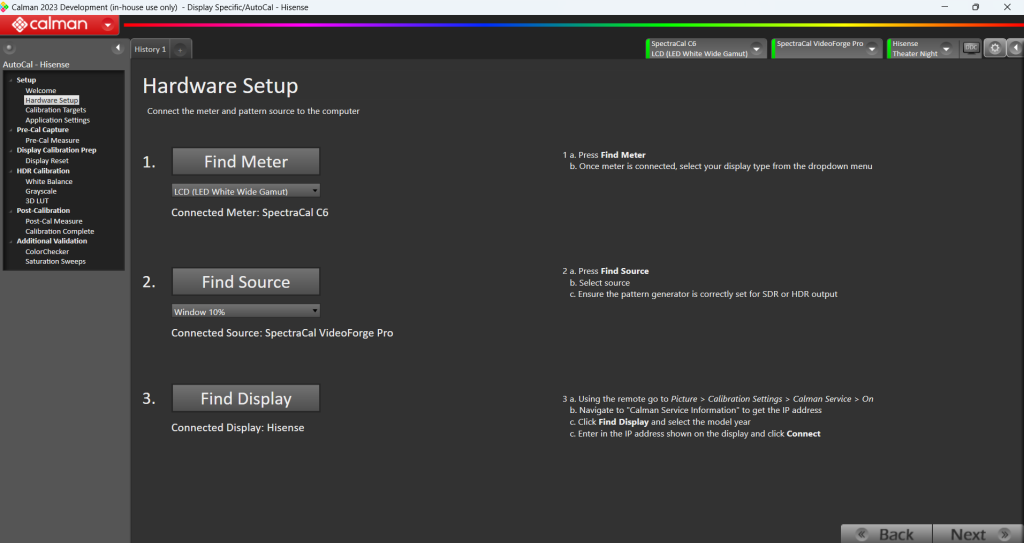
- Connect the meter: Plug your meter into a USB port on the computer and press the Find Meter button on the workflow.
- When your meter is connected, select your display type from the dropdown (this will vary by meter)
- Connect Pattern Source to your computer.
- Click the Find Source button then select your source
- Connect to the Hisense TV
- Via the TV OSD:
- Choose Settings → Picture → Calibration Settings and ensure Calman Service is enabled
- Navigate to “Calman Service Information” to get the IP address
- In Calman:
- Click Find Display and select the model year
- Enter the IP address shown on the display and click Connect
- Via the TV OSD:
Step 2
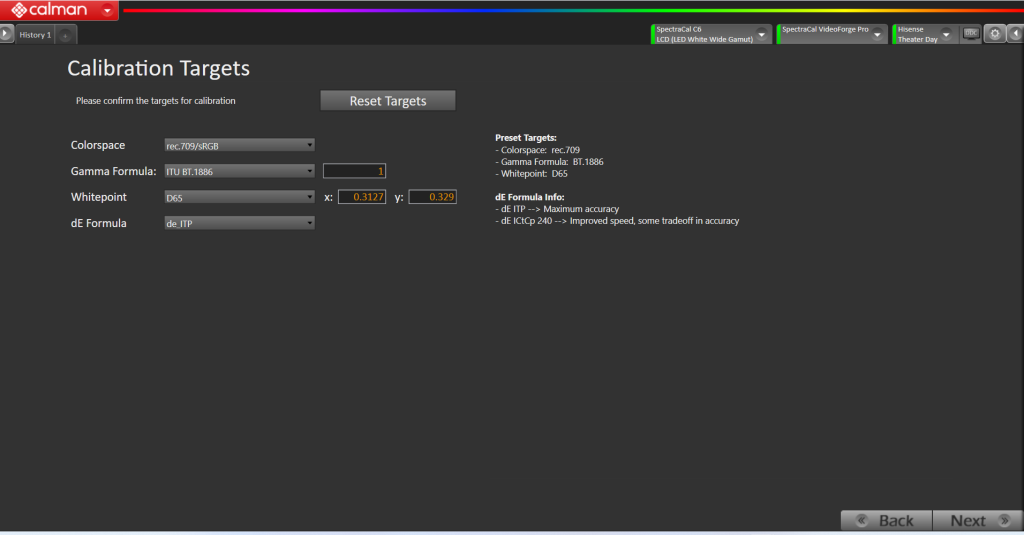

Confirm your calibration targets and prepare the TV. Settings will be automatically set as part of the workflow.
- For best SDR calibration, configure Calman settings to match the configuration recommendation provided in the workflow.
- Whitepoint: D65
- Corlorspace: Rec709
- EOFT: BT.1886
- AutoCal dE Formula
- dE ITP
- Increases accuracy, but calibration time may be extended
- dE ICtCp 240
- Improved speed, with a small tradeoff in accuracy
- dE ITP
Press Next to move to the next page
Select Set calibration mode defaults for SDR
To prevent an OLED display from entering auto-dimming mode during extended measurements, the Calman Pattern Insertion feature periodically inserts a different test pattern during measurements, to reset the display’s auto-dimming timer. This can be disabled for LCD TVs.
- Press the Set SDR Defaults to configure pattern insertion to the following parameters
- Pattern Insertion
- Frequency: 45
- Duration: 5
- Pattern Level: 25
- Pattern Stabilization
- Patches: 1
- Duration: 1
- Level: 10
- Pattern Insertion
Step 3
In this step, you’ll take readings of your display before the calibration. These will be used to compare your calibration results
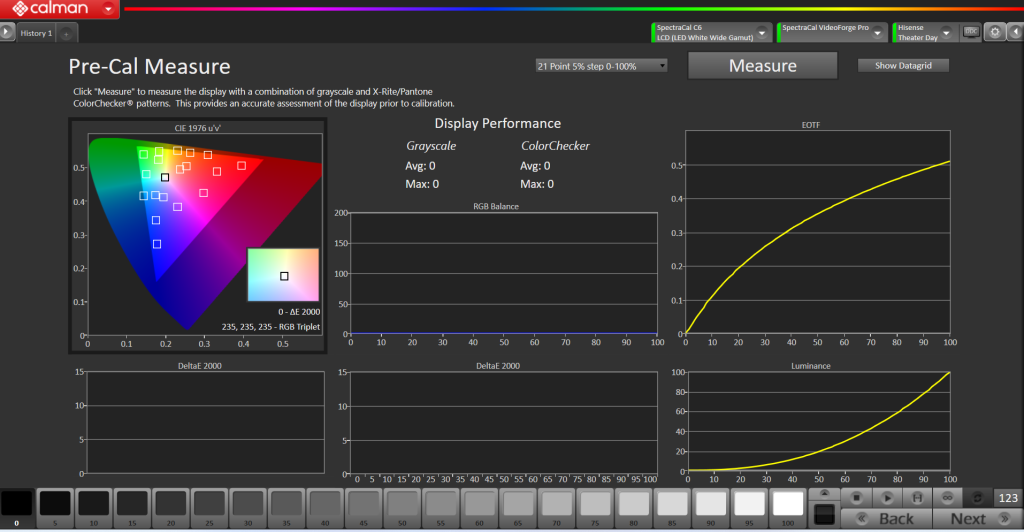


To take Pre-Calibration Measurements click the Measure button to measure the display’s grayscale and ColorChecker response
- This will provide a point of reference to compare your calibration results
Once Pre-Calibration Capture is complete, click Next
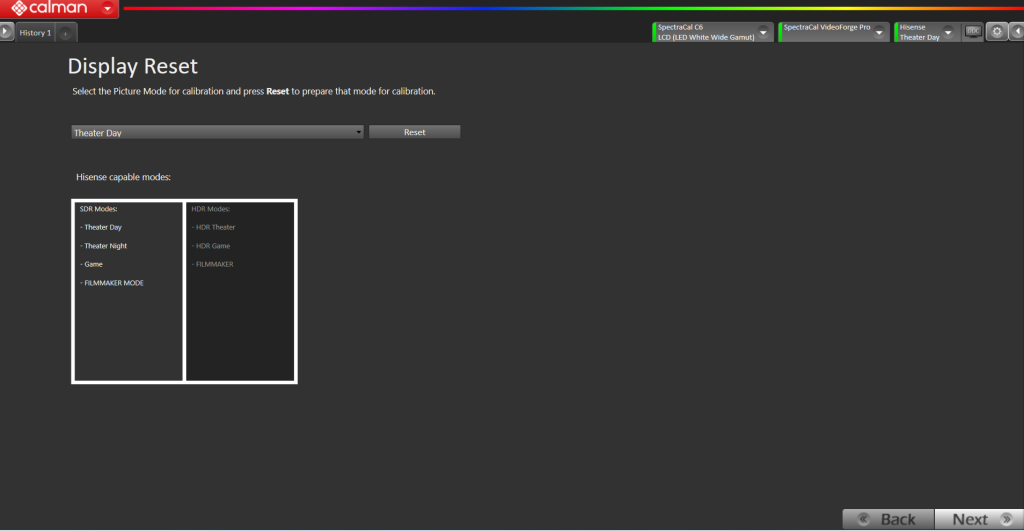


- On the Display Reset page:
- Choose the picture mode you wish to calibrate
- The following modes are available for calibration:
- Theater Day
- Theater Night
- Game
- FILMMAKER MODE
- The following modes are available for calibration:
- Click the Reset button. This resets and prepares the picture mode for calibration
- Click Next after the DDC reset is complete
- Choose the picture mode you wish to calibrate
Step 4
In this step, you will be able to adjust the Luminance of your display to match your desired target. Luminance is a subjective target. SDR reference luminance is 100cd/m2, but you may need to target higher to account for the ambient light in your environment
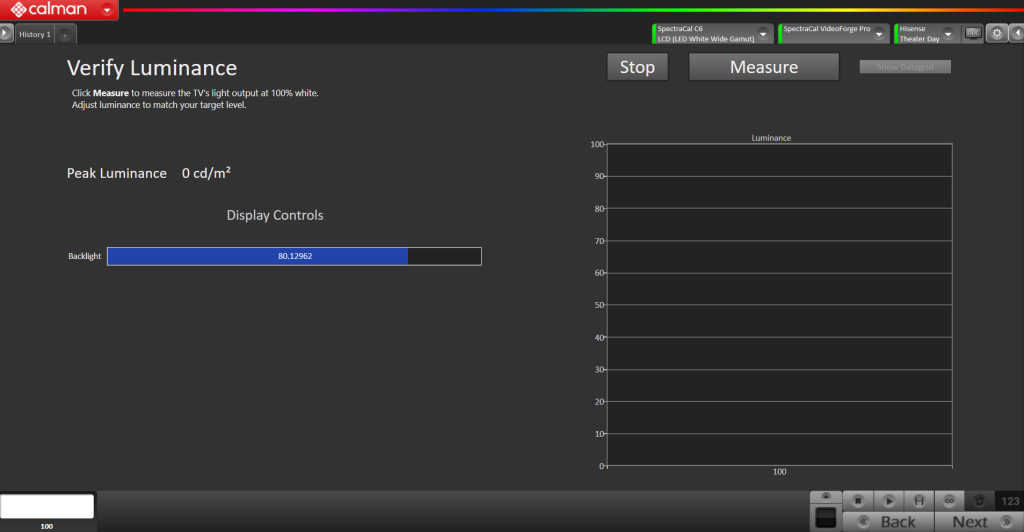

- Click the Measure button to measure your TV’s light output at 100% white and adjust the display’s peak white to the desired luminance.
- Luminance is a subjective target. SDR reference luminance is 100nits, but you may need to target higher to account for the ambient light in your environment.
- Use the Blacklight slider to adjust for the desired results.
- Press Stop when luminance adjustment is complete
Step 5
On this page, Calman will adjust your display’s White Balance
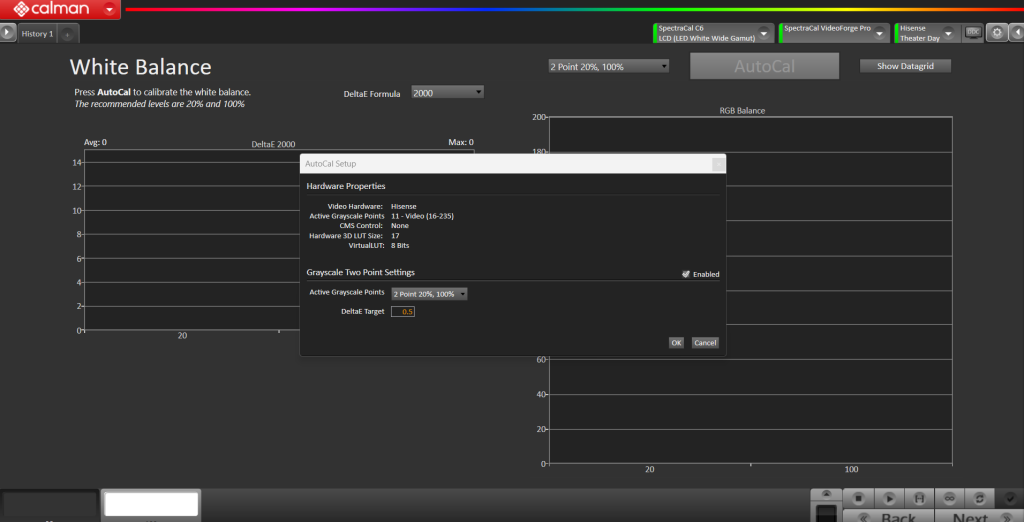


- Click the AutoCal button to perform the 2pt greyscale AutoCal
Step 6
Here Calman will adjust the Multipoint Greyscale of your display
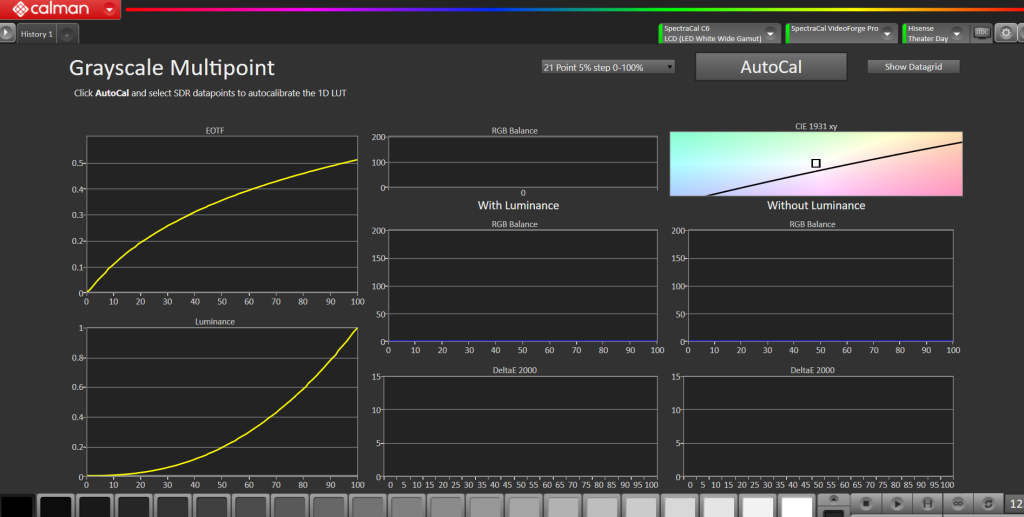


- Press the AutoCal button and verify that the SDR point set is selected
- Click OK to begin greyscale AutoCal
Step 7
On this page, Calman will calibrate the Color Management using a 3D LUT
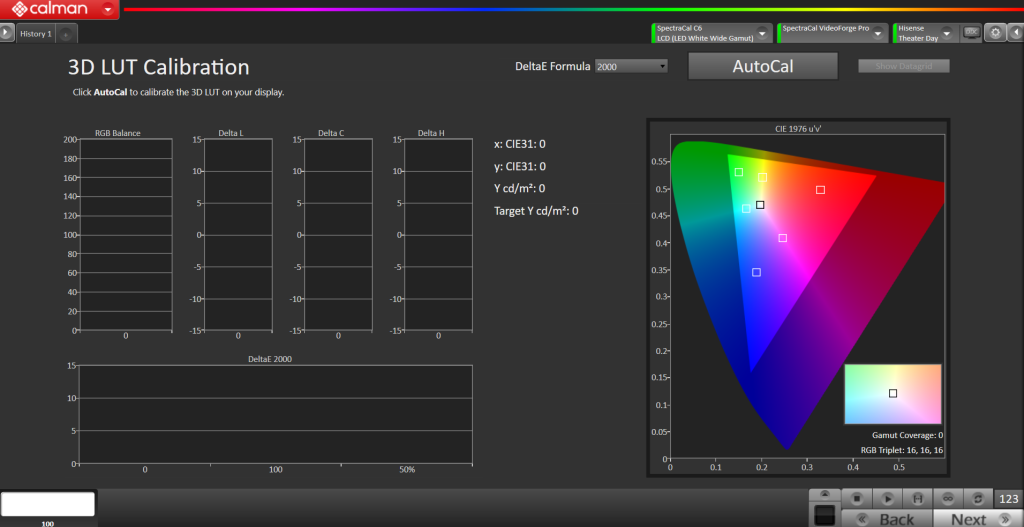


- Press the AutoCal button to open the AutoCal dialog
- Calman has multiple methods for creating a 3D LUT. For information about these LUTs see THIS ARTICLE
- Choose the video range that matches your target and pattern generator settings
- Click OK to begin the colorspace AutoCal process
- When AutoCal is complete, press the Next button to proceed
Step 8
It’s common to lose some overall luminance after the 1D LUT calibration. Use step this to adjust back to your luminance target if it has changed
- Click the Measure Peak Luminance button to measure your TV’s light output at 100% white and adjust the display’s peak white to the desired luminance.
- Use the Contrast and Blacklight slider to adjust for the desired results.
- Press Stop Measuring when luminance adjustment is complete
Step 9
Post-calibration readings to document the post-calibration condition of the display.
- Click the Read Series […] button
SDR calibration is complete
HDR Calibration
Show/Hide HDR Calibration Steps
Step 1



- Connect the meter: Plug your meter into a USB port on the computer and press the Find Meter button on the workflow.
- When your meter is connected, select your display type from the dropdown (this will vary by meter)
- Connect Pattern Source to your computer.
- Click the Find Source button then select your source
- Connect to the Hisense TV
- Via the TV OSD:
- Choose Settings → Picture → Calibration Settings and ensure Calman Service is enabled
- Navigate to “Calman Service Information” to get the IP address
- In Calman:
- Click Find Display and select the model year
- Enter the IP address shown on the display and click Connect
- Via the TV OSD:
Step 2
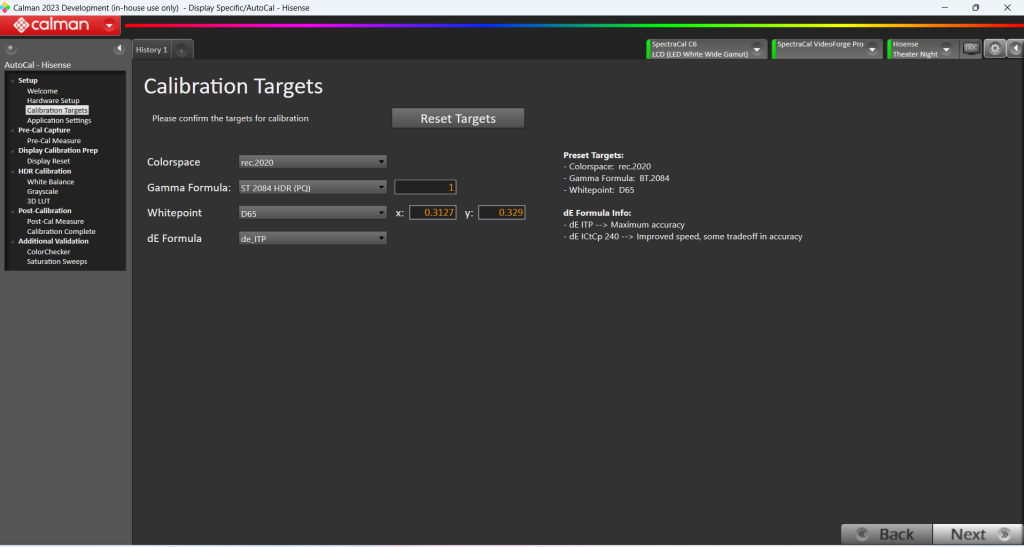

Confirm your calibration targets and prepare the TV. Settings will be automatically set as part of the workflow.
- For best SDR calibration, configure Calman settings to match the configuration recommendation provided in the workflow.
- Whitepoint: D65
- Corlorspace: Rec2020
- EOFT: BT.2084
- AutoCal dE Formula
- dE ITP
- Increases accuracy, but calibration time may be extended
- dE ICtCp 240
- Improved speed, with a small tradeoff in accuracy
- dE ITP
Press Next to move to the next page
Select Set calibration mode defaults for SDR
To prevent an OLED display from entering auto-dimming mode during extended measurements, the Calman Pattern Insertion feature periodically inserts a different test pattern during measurements, to reset the display’s auto-dimming timer. This can be disabled for LCD TVs.
- Press the Set SDR Defaults to configure pattern insertion to the following parameters
- Pattern Insertion
- Frequency: 5
- Duration: 5
- Pattern Level: 25
- Pattern Stabilization
- Patches: 1
- Duration: 1
- Level: 10
- Pattern Insertion
Step 3
In this step, you’ll take readings of your display before the calibration. These will be used to compare your calibration results
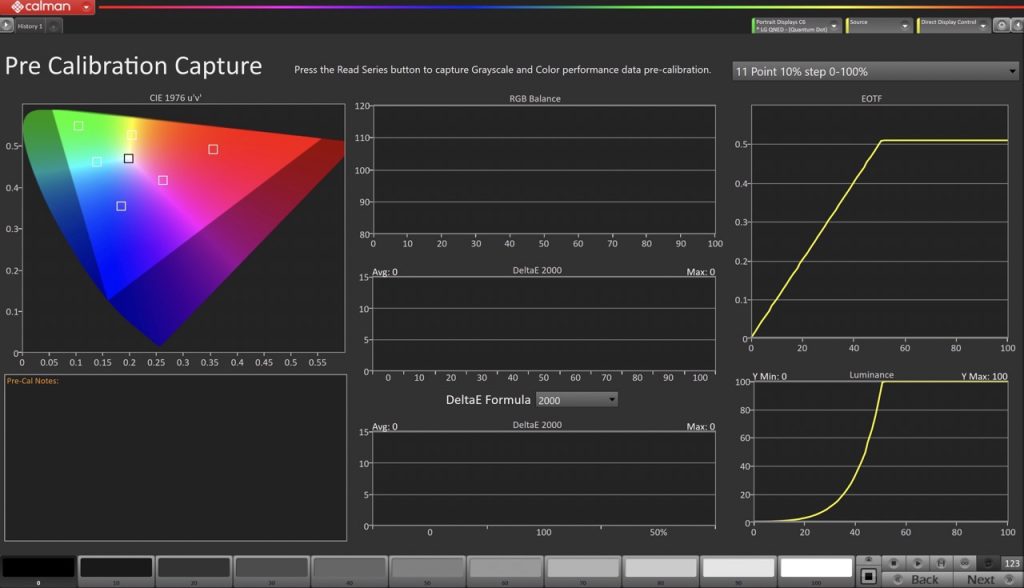

To take Pre-Calibration Measurements click the Read Series […] button to measure the display’s grayscale and ColorChecker response
- This will provide a point of reference to compare your calibration results
Once Pre-Calibration Capture is complete, click Next
Step 3
In this step, you’ll take readings of your display before the calibration. These will be used to compare your calibration results



To take Pre-Calibration Measurements click the Measure button to measure the display’s grayscale and ColorChecker response
- This will provide a point of reference to compare your calibration results
Once Pre-Calibration Capture is complete, click Next



- On the Display Reset page:
- Choose the picture mode you wish to calibrate
- The following modes are available for calibration:
- HDR Theater
- HDR Game
- HDR FILMMAKER MODE
- The following modes are available for calibration:
- Click the Reset button. This resets and prepares the picture mode for calibration
- Click Next after the DDC reset is complete
- Choose the picture mode you wish to calibrate
Step 4
On this page, Calman will adjust your display’s White Balance



- Click the AutoCal button to perform the 2pt greyscale AutoCal
Step 5
Here Calman will adjust the Multipoint Greyscale of your display



- Press the AutoCal button and verify that the HDR point set is selected
- Click OK to begin greyscale AutoCal
- Note: The calibration results should match the display default (yellow EOTF) – Note that Calman will target Power 2.2 for this display default unless directed otherwise
Step 6
On this page, Calman will calibrate the Color Management using a 3D LUT



- Press the AutoCal button to open the AutoCal dialog
- Calman has multiple methods for creating a 3D LUT. For information about these LUTs see THIS ARTICLE
- Choose the video range that matches your target and pattern generator settings
- Click OK to begin the colorspace AutoCal process
- When AutoCal is complete, press the Next button to proceed
Step 7
It’s common to lose some overall luminance after the 1D LUT calibration. Use step this to adjust back to your luminance target if it has changed
- Click the Measure Peak Luminance button to measure your TV’s light output at 100% white and adjust the display’s peak white to the desired luminance.
- Use the Contrast and Blacklight slider to adjust for the desired results.
- Press Stop Measuring when luminance adjustment is complete
Step 8
Post-calibration readings to document the post-calibration condition of the display.
- Click the Read Series […] button
HDR calibration is complete